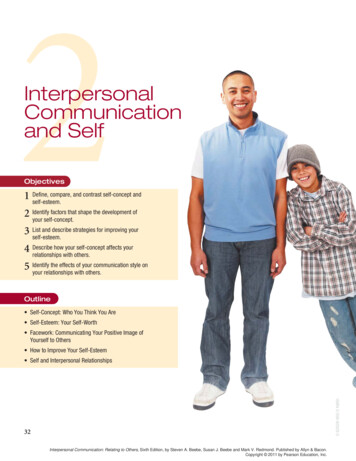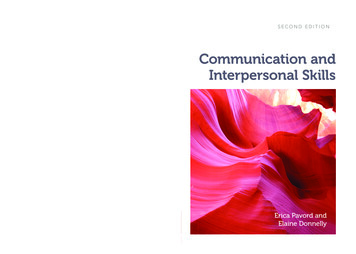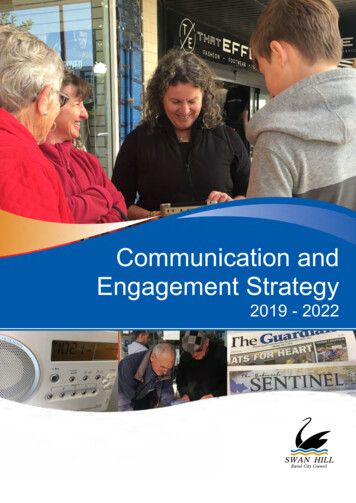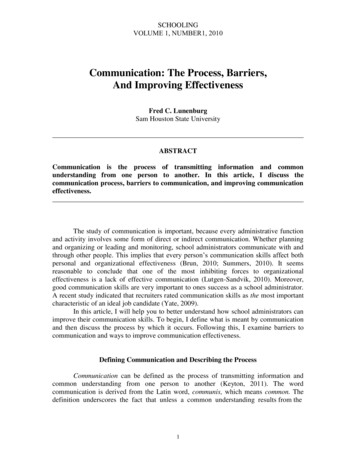
Transcription
2InterpersonalCommunicationand SelfObjectivescompare, and contrast self-concept and1 Define,self-esteem.factors that shape the development of2 Identifyyour self-concept.and describe strategies for improving your3 Listself-esteem.how your self-concept affects your4 Describerelationships with others.the effects of your communication style on5 Identifyyour relationships with others.Outline Self-Concept: Who You Think You Are Self-Esteem: Your Self-Worth Facework: Communicating Your Positive Image ofYourself to Others How to Improve Your Self-Esteem Self and Interpersonal RelationshipsISBN 0-558-82929-532Interpersonal Communication: Relating to Others, Sixth Edition, by Steven A. Beebe, Susan J. Beebe and Mark V. Redmond. Published by Allyn & Bacon.Copyright 2011 by Pearson Education, Inc.
Chapter 2PInterpersonal Communication and Selfhilosophers suggest that there are three basic questions to which all people seek answers: (1) “Who amI?” (2) “Why am I here?” and (3) “Who are all these others?” In this chapter, we focus on these essential questionsabout the self. We view them as progressive. Grapplingwith the question of who you are and seeking to define apurpose for your life are essential to understanding othersand becoming other-oriented in your interpersonal communication and relationships.Fundamentally, all your communication starts or ends with you. When you arethe communicator, you intentionally or unintentionally code your thoughts and emotions to be interpreted by another. When you receive a message, you interpret theinformation through your own frame of reference. Your self-image and self-worth, aswell as your needs, values, beliefs, and attitudes, serve as filters for your communication with others. As you establish and develop relationships, you may become moreaware of these filters and perhaps want to alter them. A close relationship often provides the impetus for change.To understand the role that self-concept plays in interpersonal communication,we will explore the first two basic questions—“Who am I?” and “Why am I here?”—inan effort to discover the meaning of self. We will examine the multifaceted dimensions of self-concept, learn how it develops, and compare self-concept to self-esteem.Then we will move to the third basic question, “Who are all these others?” What youchoose to tell and not tell others about yourself reveals important clues about who youare, what you value, and how you relate to another person.33People tell themselvesstories and then pour theirlives into the stories they tell.AnonymousISBN 0-558-82929-5Self-Concept: Who You Think You AreYou can begin your journey of self-discovery by doing the exercise in Building YourSkills: Who Are You?How did you answer the question “Who are you?” Perhaps you listed activities inwhich you participate, or groups and organizations to which you belong. You mayhave listed some of the roles you assume, such as student, child, or parent. All thesethings are indeed a part of your self, the sum total of who you are. Psychologist KarenHorney defines self as “that central inner force, common to all human beings and yetunique in each, which is the deep source of growth.”1Your answers are also part of your self-concept. Your self-concept is your subjective description of who you think you are—it is filtered through your own perceptions. For example, you may have great musical talent, but you may not believe in itenough to think of yourself as a musician. You can view self-concept as the labels youconsistently use to describe yourself to others.Who you are is also reflected in the attitudes, beliefs, and values that you hold.These are learned constructs that shape your behavior and self-image. An attitude is alearned predisposition to respond to a person, object, or idea in a favorable or unfavorable way. Attitudes reflect what you like and what you don’t like. If you like school,butter pecan ice cream, and your brother, you hold positive attitudes toward thesethings. You were not born with a fondness for butter pecan ice cream; you learned tolike it, just as some people learn to enjoy the taste of snails, raw fish, or pureed turnips.Beliefs are the way in which you structure your understanding of reality—what istrue and what is false for you. Most of your beliefs are based on previous experience.self Sum total of who a person is;a person’s central inner force.self-concept A person’s subjectivedescription of who he or she is.attitude Learned predisposition torespond to a person, object, or ideain a favorable or unfavorable way.belief Way in which you structureyour understanding of reality—whatis true and what is false for you.Interpersonal Communication: Relating to Others, Sixth Edition, by Steven A. Beebe, Susan J. Beebe and Mark V. Redmond. Published by Allyn & Bacon.Copyright 2011 by Pearson Education, Inc.
34Part OneInterpersonal Communication FoundationsBuilding Your SkillsConsider this question: Who are you?More specifically, ask yourself this question ten times. Write your responses inthe spaces provided here or on a separate piece of paper. It may be challenging to identify ten aspects of yourself.The Spanish writer Miguel de Cervantessaid, “To know thyself . . . is the mostdifficult lesson in the world.” Youranswers will help you begin to exploreyour self-concept and self-esteem inthis chapter.value Enduring concept of goodand bad, right and wrong.Who Are You?I amI amI amI amI amI amI amI amI amI amYou believe that the sun will rise in the morning and that you will get burned if youput your hand on a hot stove.How are attitudes and beliefs related? They often function quite independently ofeach other. You may have a favorable attitude toward something and still believe negativethings about it. You may believe, for example, that your school football team will not winthe national championship this year, although you may be a big fan. Or you may believethat God exists, yet not always like what you think God does or does not do. Beliefs haveto do with what is true or not true, whereas attitudes reflect likes and dislikes.Values are enduring concepts of good and bad, right and wrong. Your values aremore resistant to change than either your attitudes or your beliefs. They are also moredifficult for most people to identify. Values are so central to who you are that it is difficult to isolate them. For example, when you go to the supermarket, you may spend afew minutes deciding whether to buy regular or cream-style corn, but you probablydo not spend much time deciding whether you will steal the corn or pay for it. Ourvalues are instilled in us by our earliest interpersonal relationships; for almost all of us,our parents shape our values.The model in Figure 2.1 illustrates that values are central to our behavior andconcept of self and that what we believe to be true or false stems from our values;that’s why values are in the center of the model. Attitudes are at the outer edge of thecircle because they are the most likely to change. You may like your coworker todayRECAP Who You Are Is Reflected in Your Attitudes, Beliefs, and ValuesDimensionsExampleAttitudeLearned predisposition to respond favorablyor unfavorably to somethingLikes–DislikesYou like ice cream, incense, and cats.BeliefThe way in which you structure realityTrue–FalseYou believe that your parents love you.ValueEnduring concepts of what is right and wrongGood–BadYou value honesty and truth.Interpersonal Communication: Relating to Others, Sixth Edition, by Steven A. Beebe, Susan J. Beebe and Mark V. Redmond. Published by Allyn & Bacon.Copyright 2011 by Pearson Education, Inc.ISBN 0-558-82929-5Definition
Chapter 2Interpersonal Communication and Selfbut not tomorrow, even though you believe the person will come to workevery day and you still value the concept of friendship. Beliefs are betweenattitudes and values in the model because they are more likely to changethan our core values but don’t change as much as our attitudes (likes anddislikes).Are You Conscious of Who You Are?Va l u e sDo you know what you’re doing right now? “Of course,” you may think,Beliefs“I’m reading this textbook.” But are you really aware of all of the fleetingthoughts bouncing in your head, whether you’re truly happy or sad, orAttitudeseven whether you may be twiddling a pencil, jiggling your leg, or in needof a snack? To be aware of who you are and what you may be thinkingabout is a more involved process than you may think. To be self-aware is FIGURE 2.1to be mindful. Mindfulness is the ability to consciously think about whatValues, Beliefs, and Attitudesyou are doing and experiencing, rather than responding out of habit or in Relation to Selfintuition.2 If you’ve ever talked on the phone while driving (somethingillegal in many states), you may not have been mindful of, or consciouslythinking about, where you were driving. Researchers have described three ways ofbeing self-aware, or conscious of who you are and what you are doing: subjective selfawareness, objective self-awareness, and symbolic self-awareness.3Subjective Self-Awareness. Subjective self-awareness is the ability that peo-ple have to differentiate themselves from their environment. You are a separate beingapart from your surroundings. It is so basic an awareness that it may even seem notworth talking about. You know, for example, that you’re not physically attached to thechair you may be sitting in. You are a separate entity from all that is around you.Objective Self-Awareness. Objective self-awareness is the ability to be theobject of our own thoughts and attention. You have the ability to think about yourown thoughts as you are thinking about them. (Some research suggests that some primates also have this ability.) Not only are you aware that you’re separate from yourenvironment (subjective self-awareness), but you can also ponder the distinctthoughts you are thinking. Of course, objective self-awareness, like subjective selfawareness, can be “turned on” and “turned off.” Sometimes you are aware of whatyou are thinking, sometimes you’re unaware of what you are thinking or on what youare focusing.Symbolic Self-Awareness. Symbolic self-awareness, unique to humans, isISBN 0-558-82929-5our ability not only to think about ourselves but to use language (symbols) to represent ourselves to others. For example, you have the ability to think about how to makea good impression on others. In an effort to make a positive impression on someone,you may say, “Good evening, Mrs. Cleaver. You look nice this evening” rather thanjust saying, “Hi ya.” You make conscious attempts to use symbols to influence the wayyou want to be perceived by others.A four-stage model of how aware or unaware we are of what we are doing at anygiven moment has been attributed to psychologist Abraham Maslow. This frameworkhas also been used to explain how individuals develop communication skills.Stage 1: Unconscious incompetence. You are unaware of your own incompetence.You don’t know what you don’t know. For example, at one point in your life youdidn’t know how to ride a bicycle and you didn’t even realize that you were missing this skill. You were unconsciously incompetent about bicycle-riding skills.mindfulness The ability toconsciously think about whatyou are doing and experiencing.subjective self-awarenessAbility to differentiate the selffrom the social and physicalenvironment.objective self-awarenessAbility to be the object of one’sown thoughts and attention—tobe aware of one’s state of mindand that one is thinking.symbolic self-awarenessUniquely human ability to thinkabout oneself and use language(symbols) to represent oneself toothers.Interpersonal Communication: Relating to Others, Sixth Edition, by Steven A. Beebe, Susan J. Beebe and Mark V. Redmond. Published by Allyn & Bacon.Copyright 2011 by Pearson Education, Inc.35
Stage 2: Conscious incompetence. At this level, you become aware orconscious that you are not competent: You know what you don’tknow. Continuing our example, at some point you realized thatothers could ride a bike and you could not. You became consciousof your incompetence with regard to bicycle-riding.Peter Blake, “Self-Portrait with Badges,” 1961. Tate Gallery, London/Art Resource, NY. 2009 Artists Rights Society (ARS), New York/DACS, LondonStage 3: Conscious competence. You are aware that you know something, but applying it has not yet become a habit. When you firstlearned to ride a bike, if you’re like most people, you had to concentrate on keeping your balance and focus on riding forwardwithout falling over.Stage 4: Unconscious competence. At this level, your skills becomesecond nature to you. Now you don’t have to mentally review howto ride a bike every time you hop on one. You are unconsciouslycompetent of how to ride a bicycle; you just get on and automatically start pedaling. The same could be said about tying yourshoes; you don’t have to think about how to tie your shoes; youjust do it without thinking about each step. These same four stagesexplain how you learn any skill, from riding a bike to enhancingthe interpersonal communication skills we discuss in this book.One or Many Selves?Shakespeare’s famous line “To thine own self be true” suggests thatyou have a single self to which you can be true. But do you have justone self? Or is there a more “real you” buried somewhere within?Most scholars conclude that each of us has a core set of behaviors,attitudes, beliefs, and values that constitutes our self—the sum total of who we are. Butour concept of self can and does change, depending on circumstances and influences.In addition, our self-concept is often different from the way others see us. Wealmost always behave differently in public than we do in private. Sociologist ErvingGoffman suggests that, like actors and actresses, we have “on-stage” behaviors whenothers are watching and “backstage” behaviors when they are not.4 Goffman writesthat “often what talkers undertake to do is not to provide information to a recipientbut to present dramas to an audience. Indeed, it seems that we spend most of our timenot engaged in giving information but in giving shows.”5 With an audience present,whether it’s one person or several, you adapt and “perform.”Perhaps the most enduring and widely accepted framework for describing whowe are was developed by the philosopher William James. He identified three classiccomponents of the self: the material self, the social self, and the spiritual self.6Peter Blake sought to explore his self-dimensions bypainting his self-portrait. What qualities does this selfportrait reveal about the artist?The Material Self. Perhaps you’ve heard the statement “You are what you eat.”reflected in a total of all thetangible things you own.36Interpersonal Communication: Relating to Others, Sixth Edition, by Steven A. Beebe, Susan J. Beebe and Mark V. Redmond. Published by Allyn & Bacon.Copyright 2011 by Pearson Education, Inc.ISBN 0-558-82929-5material self Concept of self asThe concept of the material self goes a step further by suggesting that “You are whatyou have.” The material self is a total of all the tangible things you own: your body,your possessions, your home. As you examine your list of responses to the question“Who are you?” note whether any of your statements refer to one of your physicalattributes or something you own.One element of the material self gets considerable attention in this culture: thebody. Do you like the way you look? Most of us, if we’re honest, would like tochange something about our appearance. When there is a discrepancy between ourdesired material self and our self-concept, we may respond to eliminate the discrepancy. We may try to lose weight, develop our muscles, or acquire more hair. The
Chapter 2Interpersonal Communication and Self37multibillion-dollar diet industry is just one of manythat profit from our collective desire to change ourappearance.The Social Self. Look at your “Who are you?” The New Yorker Collection Peter C. Vey fromcartoonbank.com. All Rights Reservedlist once more. How many of your responses relate toyour social self, the part of you that interacts withothers? William James believed that you have manysocial selves—that, depending on the friend, familymember, colleague, or acquaintance with whom youare interacting, you change the way you are. A personhas, said James, as many social selves as there are people who recognize him or her. For example, when youtalk to your best friend, you are willing to “let downyour hair” and reveal more thoughts and feelings thanyou would in a conversation with your communication professor, or even your parents. Each relationship that you have with another person is uniquebecause you bring to it a unique social self.The Spiritual Self. Your spiritual self consists of all your thoughts and intro-spections about your values and moral standards. It does not depend on what youown or with whom you talk; it is the essence of who you think you are and yourfeelings about yourself, apart from external evaluations. It is an amalgam of your religious beliefs and your sense of who you are in relationship to other forces in the universe. Whether you believe in intelligent design or Darwinian evolution (or both),UNDERSTANDING OTHERSISBN 0-558-82929-5Adapting to DifferencesIt’s clear that there are cultural differencesamong the world’s people, including differences in language, food preferences,housing preferences, and a host of otherelements; these differences have existedas long as there have been people.Anthropologistsandcommunicationscholars who study intercultural communication, a topic we’ll discuss in moredetail in Chapter 4, teach the value ofadapting to cultural differences in order tounderstand others better. But is it possible that despite their clear differences,there is a universally held principle thatinfluences the behavior of all people? Thequestion is not a new one. Scholars, theologians, and many others have debatedfor millennia whether there are any universal values that inform all human societies.The importance of being other-orientedrather than self-absorbed is not a new idea.social self Concept of self asreflected in social interactionswith others.spiritual self Concept ofself based on thoughts andintrospections about personalvalues, moral standards, and beliefs.The “Golden Rule”: A Universal Value?Most world religions emphasize some version of the same spiritual principle, known inChristianity as the Golden Rule: Do untoothers as you would have others do untoyou. There is convincing evidence that thisrule has been the foundation of most ethicalcodes throughout the world. The followingprinciples underlying various religious traditions emphasize the universal importanceaccorded to being other-oriented.7Hinduism This is the sum of duty: Donothing to others that would cause pain ifdone to you.Buddhism One should seek for othersthe happiness one desires for one self.Taoism Regard your neighbor’s gain asyour own gain, and your neighbor’s lossas your loss.Confucianism Is there one principle thatought to be acted on throughout one’swhole life? Surely it is the principle ofloving-kindness: do not unto others whatyou would not have them do unto you.Zoroastrianism The nature alone isgood that refrains from doing untoanother whatsoever is not good for itself.Judaism What is hateful to you, do notdo to others. That is the entire law: all therest is but commentary.Islam No one of you is a believer untilhe desires for his brother that which hedesires for himself.Christianity Do unto others as youwould have others do unto you.Do you find this list of variations on theGolden Rule from different world religionsconvincing evidence that being otheroriented is a universal value? Are thereother underlying values or principles, suchas how the poor or the elderly should betreated, that should inform our interactionswith others?Interpersonal Communication: Relating to Others, Sixth Edition, by Steven A. Beebe, Susan J. Beebe and Mark V. Redmond. Published by Allyn & Bacon.Copyright 2011 by Pearson Education, Inc.
38Part OneInterpersonal Communication Foundationsyour beliefs about the ultimate origins of the world (and about your own origins andultimate destination) are embedded in your spiritual self. Your spiritual self is the partof you that answers the question “Why am I here?”RECAP William James’s Dimensions of SelfDefinitionExamplesMaterial SelfAll the physical elements that reflect who you areBody, clothes, car, homeSocial SelfThe self as reflected through your interactions withothers; actually, a variety of selves that respond tochanges in situations and rolesYour informal self interacting with yourbest friend; your formal self interactingwith your professorsSpiritual SelfIntrospections about values, morals, and beliefsBelief or disbelief in God; regard for life in all its formsBEINGOther-ORIENTEDOne of the ways we develop ourself-concept is by interactingwith others. Who are the othersin your life who have had themost profound impact on whoyou are? Most people wouldsay their parents and membersof their family. Who besidesfamily members have helpedto shape your concept of self?In what ways?Some psychologists and sociologists have advanced theories that suggest you learn whoyou are through five basic means: (1) interactions with other individuals, (2) associations with groups, (3) roles you assume, (4) self-labels, and (5) your personality. LikeJames’s framework, this one does not cover every base in the study of self, but its constructs can provide some clues about how your own self-concept develops.Interaction with Individuals. In 1902, Charles Horton Cooley first advancedthe concept of the looking-glass self, which was his term for the notion that we formour self-concept by seeing ourselves in a kind of figurative looking glass: We learn whowe are by interacting with others, much as we look into a mirror and see our reflection.8Like Cooley, George Herbert Mead also believed that our sense of who we are is a consequence of our relationships with others.9 And Harry Stack Sullivan theorized that frombirth to death our selves change primarily because of how people respond to us.10 Onesage noted, “We are not only our brother’s keeper; we are our brother’s maker.”The process begins at birth. Our names, one of the primary ways we identify ourselves, are given to us by someone else. During the early years of our lives, our parentsare the key individuals who reflect who we are. If our parents encouraged us to playthe piano, we probably play now. As we become less dependent on our parents, ourfriends become highly influential in shaping our attitudes, beliefs, and values. Andfriends continue to provide feedback on how well we perform certain tasks. This, inturn, helps us shape our sense of identity as adults—we must acknowledge our talentsin math, language, or art in our own minds before we say that we are mathematicians,linguists, or artists.Fortunately, not all feedback affects our sense of who we think we are. We are likelyto incorporate the comments of others into our self-concept under three conditions.First, we are more likely to believe another’s statement if he or she repeats something we have heard several times. If one person casually tells you that you have agood singing voice, you are not likely to launch a search for an agent and a recordingcontract. But if several individuals tell you on many different occasions that you havea talent for singing, you may decide to do something about it.Second, we are more likely to value another’s statements if we perceive him or herto be credible. If we believe the individual is competent, trustworthy, and qualified tomake a judgment about us, then we are more likely to believe the person’s assessment.Third, we are likely to incorporate another’s comments into our own concept ofself if the comments are consistent with other comments and our own experience. Ifyour boss tells you that you work too slowly, but for years people have been urgingInterpersonal Communication: Relating to Others, Sixth Edition, by Steven A. Beebe, Susan J. Beebe and Mark V. Redmond. Published by Allyn & Bacon.Copyright 2011 by Pearson Education, Inc.ISBN 0-558-82929-5looking-glass self Concept thatsuggests you learn who you arebased on your interactions withothers, who reflect your self backto you.How Your Self-Concept Develops
Chapter 2Interpersonal Communication and Selfyou to slow down, then your previous experience will probably encourage you tochallenge your boss’s evaluation.Not surprisingly, your parents or early caregivers played an important role ininfluencing your self-concept. Researchers have found that the emotional and relational bond that you developed early on with your parents—or, to phrase this anotherway, how attached you felt to one or both of your parents or primary caregiver—influenced your concept of self, and that continues to influence how you relate to others.11According to several researchers, you develop an attachment style based on howsecure, anxious, or uncomfortable you felt in relating to one or both of your parents.12Research suggests that you developed one of three different types of attachment styles:secure, anxious, or avoidant.13You have a secure attachment style if you are comfortable giving and receivingaffection, experiencing intimacy, and trusting other people. If you have a secureattachment style, then you probably developed a strong, trusting, close, predictable,and positive emotional bond with your parents. Research suggests the majority ofpeople, about 60 percent, develop a secure attachment style.14You may have developed an anxious attachment style if you received some affection but not quite enough, and so you may feel uncomfortable in some relationships;the affection you received from your parents was not always predictably present. It’snot that you received no affection from your caregivers, but you didn’t receive all thatyou felt you needed and therefore you may experience some anxiety about intimacyand giving and receiving affection. About 10 percent of the population develops ananxious attachment style.15Finally, you may have an avoidant attachment style if you consistently receivedtoo little nurturing. People who had this type of upbringing may feel considerable discomfort and awkwardness when expressing or receiving intimacy. Because they didn’treceive adequate affection and emotional connections as children, such people maytend to avoid relational intimacy with others. About 25 percent of the population fitsthis attachment style profile.16Your concept of yourself as someone who enjoys strong emotional connectionswith other people, or as someone who is anxious or avoids relational intimacy, is thusinfluenced by the degree of attachment you felt during your formative years. Obviously, you should neither blame nor congratulate your parents for everything aboutthe way you relate to people today. But research suggests that early relationship connections with our parents do influence the way we relate to others.Associations with Groups. Reflect once more on your responses to the“Who are you?” question. How many responses associate you with a group? Religiousgroups, political groups, ethnic groups, social groups, study groups, and occupationaland professional groups play important roles in determining your self-concept. Someof these groups you are born into; others you choose on your own. Either way, thesegroup associations are significant parts of your identity.Associating with groups is especially important for people who are not part of thedominant culture. Gays and lesbians, for example, find the support provided by associating with other gays and lesbians to be beneficial to their well-being. The groupsyou associate with not only provide information about your identity, but also provideneeded social support.39attachment style A style ofrelating to others that developsearly in life, based on the emotionalbond one forms with one’s parentsor primary caregiver.secure attachment style Thestyle of relating to others that ischaracteristic of those who arecomfortable giving and receivingaffection, experiencing intimacy,and trusting other people.anxious attachment styleThe style of relating to othersthat is characteristic of those whoexperience anxiety in some intimaterelationships and feel uncomfortablegiving and receiving affection.ISBN 0-558-82929-5avoidant attachment styleRoles You Assume. Look again at your answers to the “Who are you?” ques-tion. Perhaps you see words or phrases that signify a role you often assume. Father,aunt, sister, uncle, manager, salesperson, teacher, and student are labels that implycertain expectations for behavior, and they are important in shaping self-concept.Couples who live together before they marry often report that marriage alters theirThe style of relating to othersthat is characteristic of those whoconsistently experience discomfortand awkwardness in intimaterelationships and who thereforeavoid such relationships.Interpersonal Communication: Relating to Others, Sixth Edition, by Steven A. Beebe, Susan J. Beebe and Mark V. Redmond. Published by Allyn & Bacon.Copyright 2011 by Pearson Education, Inc.
40Part OneInterpersonal Communication Foundationsrelationship. Before, they may have shared domestic duties such as doing dishes andlaundry. But when they assume the labels of “husband” and “wife,” they slip into traditional roles. Husbands don’t do laundry. Wives don’t mow the grass. These stereotypicalrole expectations that they learned long ago may require extensive discussion and negotiation. Couples who report the highest satisfaction with marriage agree on their expectations regarding roles (“We agree that I’ll do laundry and you’ll mow the grass”).17One reason we assume traditional roles automatically is that our gender groupa
you are thinking, sometimes you’re unaware of what you are thinking or on what you are focusing. Symbolic Self-Awareness.Symbolic self-awareness,unique to humans, is our ability not only to think about ourselves but to use language (symbols) to repre-sent ourselves to others. For example,











